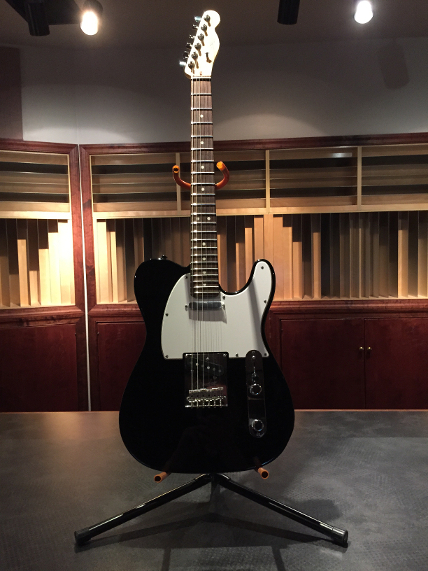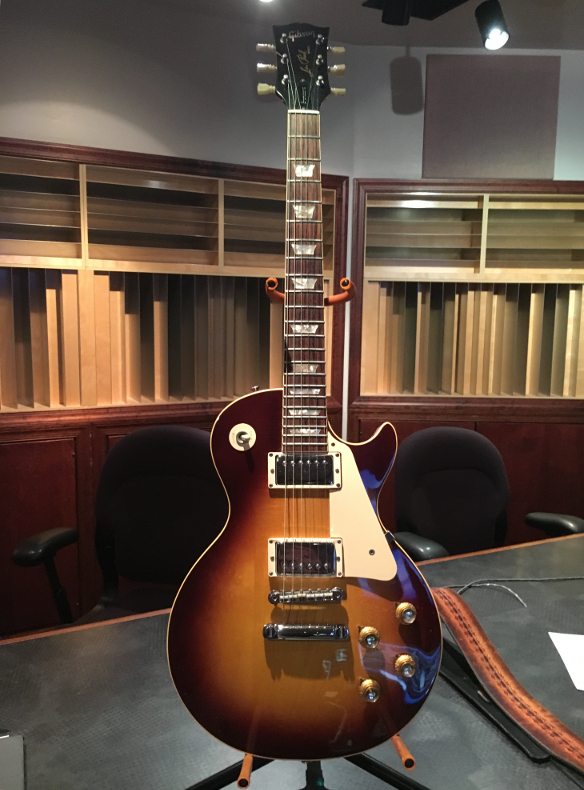Creating Layers of Guitar in a Recording

I recently spent the day overdubbing electric guitar on an interesting vocal pop project that needed some help. For this call I took the '74 Les Paul Standard, the late model American Standard Tele, and the Line Six POD HD500X featuring presets tweaked up nicely with my special sauce. This was another rescue project: I needed to bail out a song whose tension structure was simply not working by creating guitar parts that would draw the listener through it.
As it turned out, I ended up doing all the tracks with the Tele. I used the POD's input impedance selector to match it up to the guitar, optimize the sound, and give some fullness. I chose my favorite POD preset that is based upon the Fender® Blackface Deluxe Reverb® ("Normal" channel) model. I've got this one tweaked up for one-stop shopping in the studio: it is gained up moderately, trebles midway, bass one third, brilliance right below midway. In front of the amp I’ve got a touch of compression and a Line 6 Drive (Colorsound Tone Bender) that is switched off but is easily available if I need it. On the backside or "studio end" of the signal chain within the the HD500X I’ve got an EQ, a digital reverb, and a tiny bit of echo, all placed after the cabinet mic so that they don't saturate the amp model. There's not a whole lot of bass in the sound so that it doesn't fill out the lower midrange of a mix and make it too thick sounding. A tweak here and a tweak there and this sound can cover an amazing amount of ground with a minimum of fuss.

For this song, the composer brought me tracks of grand piano, bass, some percussion, and strings, for the purpose of overdubbing vocals. Somewhere along the line my co-producer who is also the vocal artist asked me to sign on as co-producer, "make the song work," and execute the final mix. I initially recorded a live drum kit, the acoustic rhythm and lead guitars (played by the composer), and both the lead and lush harmony vocals performed by the artist and her daughter. At that point what the song was lacking was dynamics and a compelling push to drive the listener through from one section of the song to another. I decided to go with electric guitar to create the necessary excitement. During downtime surrounding the prior sessions I put together some of the parts, sitting in between the monitors with an acoustic guitar. The rest were composed on the fly as I did the overdubs. I started the process by creating a bunch of empty recording tracks in the DAW so that I wouldn’t have to do a lot of mouse clicking with the guitar in my hands. Session pacing and rhythm are especially important when I'm wearing the multiple hats of producer, engineer, and musician. Next I built up the basic electric rhythm guitar parts, chug-a-chugging along very quietly in order to give the song more fullness and more of a pulse and muscle. The pulse began gently at the beginning and developed its muscle from there. These parts would initially figure very quietly in the mix, almost not even present, no more than a hint of a rumor. As the song's intensity developed, their complexity and volume developed as well. I should mention that I record parts like this twice, paying attention to tightly synchronized performances, and pan them outboard so that I leave a space in the center for the vocals.
Next I wrote some mix automation to bring those parts up and down; up when there wasn’t solo voice or instrument or voice, down when there was. The song still felt thin whenever there wasn’t a lead interest so I knew what I needed to do: I created some call-and-response chordal accents against the vocals, filling out the places where the tension structure of the song had been allowed to flatten out or sag momentarily in the absence of a lead instrument or voice. It is important to not be in competition with the vocals, and that is where the call-and-response form works extremely well. Finally I added some combined chordal and single-string melodic lead guitar parts as responses to the vocal lines. These showed up as featured parts in the middle eight and at the end in order to put a nice finish on the song. Because I was using a hard-tailed Tele I had to employ several interesting techniques to give the lines some interest:
- Creating selective vibrato on certain notes within a chord by squeezing just those strings behind the nut with my right hand
- Creating vibrato across a whole chord by wiggling the neck while anchoring the body with my right elbow
- Using lowered tunings to allow finger vibrato on pitches that would normally be at the nut and to execute odd accent chords
- Employing fingerstyle to allow combined chordal rhythm and lead parts
- Employing slide-ons and offs of a single string while holding a chord
When you are playing against basically static-pitch instruments like piano, sometimes you've got to just reach down and wobble the pitch a tiny bit so that the guitar interacts with the other instruments dynamically instead of just sitting there like a dead thing. The Tele performed like a champ in this context, supplying plenty of grit and character without adding too much sludge. Finally, all the guitar parts were panned away from the center to broaden up the mix but leave physical space in the center for the lead vocals. The result? Whenever my stacked guitar effects or the harmony vocals arrive, the mix just gets HUGE, spreading across the soundstage. When they are absent, the mix simplifies, centralizes a bit, and emphasizes the solo vocals more.
At the end of the day I had a guitar-playing friend come in for a visit so I let him listen to the mix. After he listened through the rough mix and we discussed it I invited him to play the guitars. He was drawn to the old Les Paul. I've got its pickups (the original ‘70s T-tops) set down pretty low to give the sound character and I’ve set the bass side of the neck pickup way low so that it doesn't sound tubby and so the two pickups just blend marvelously. The guitar just has so much character and warmth. My visitor and I sat around trading licks for a while with the LP. I bought that one used in '77 in my hometown, Knoxville, Tennessee, as I was ramping up involvement with a group. It has been a great companion through lots of bands and sessions. There were many times when my family was young when I was ready to sell it to handle the family’s financial obligations but my wife always stopped me. Thanks, babe.

That evening I took home a rough mix and listened on my home monitors, taking notes and trying to figure to how to make everything sit nicely in the mix. Overall I'm extremely pleased with the result. I had a blast working on the overdbs! And on the day of the session I could tell how much fun I had: I got so wrapped up that I completely lost track of time, worked through breaks and lunch, developed a headache, and ended up exhausted and spent. ***Joy*** Sometimes well-earned exhaustion is its own reward.
The verdict?
After four days of refining the mix I brought in my artist/co-producer to present the results. Halfway through the playback she was out of her chair, yelling for joy, and was eventually moved to tears by the mix, production, and guitar work. I actually had to stop down the playback and get her some tissues. I suppose that is success enough, eh?
= =
=



